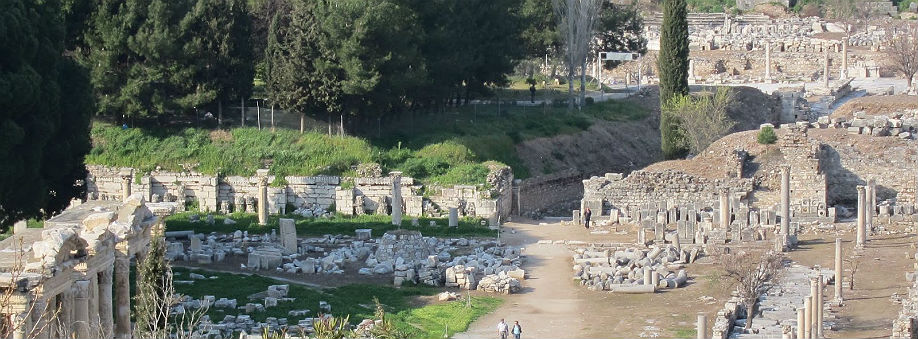There are two agoras in Ephesus, the State Agora and the Trade Agora. The Trade Agora lies to the west of the city near the Celsus Library, the level area looking like a square to the south of the Basilica with not very many remains on it is the famous State Agora of Ephesus. Of the columned portico which once surrounded it on three sides not much remains. In the middle of the square are the remains of a rectangular building which were the foundations of the Temple of Isis. It is known that because of Cleopatra and Antonius the Emperor Augustus did not like Egyptians much. Therefore it is thought that the temple was destroyed during the reign of Augustus.
After the destruction of the temple the group of statues Polyphemus which was in the pediment was taken from there and placed on the side of the pool of the Pollio Fountain which was constructed on the west side of the Agora with its face towards the Domitian Square. The ranging of these statues in the pediment of the temple and on the side of the pool of the Pollio Fountain are shown separately today in the Ephesus Museum.
As the statues were dated back to the 1st century BC from a stylistic point of view, it was assumed that the temple was also built at this time. The Agora took its last shape in the period of Augustus. Also the existence of an earlier Agora was learned through borings. A columned road ran along the south side, but in spite of this the north side must have been the main orientation of the Agora. The Prytaneum, the Odeum and the Bouleuterion stood side by side there. The State Agora was used together with the buildings surrounding it as Ephesus1 centre of administration.
At its southeast end there was an important cistern of the city, and at its southwest corner stood the Fountain of Laecanius Bassus. This structure of which restoration is not yet begun had a facade with two tiers of columns. With the large pool in front it was of quite a splendid aspect. The statues of Nymphs and Tritons are on display in the Ephesus Museum.
The State Agora,



The square structure built immediately alongside the Basilica is the State Agora of Ephesus which is reached from the Basilica by four steps. This Agora, which was built during the Roman Period over the existing 2nd century B.C Agora, was where all the city’s business other than commerce was conducted. Exploratory excavations made in the northeast corner of the Agora have turned up a great number of graves from the.7th through 6th centuries B.C and a stone-paved road, and a archaic sarcophagus of terra cotta was found here. From this it is understood that in the archaic period this section served as the necropolis of Ephesus.
Model of the State Agora:
1- Baths of Vedius,
2- Basilica,
3- Odeion,
4- Temple of Divus Julius,
5-Prytaneion,
6- Memmius Monument,
7- Garland frieze,
8-Fountain of Pollio,
9- Temple of Isis,
10- South hall,
11- Fountain of Laecanius Bassus,
12- Temple of Domitian, 13- Fountain.
The Agora is 160 metres long and 73 metres wide and appears to have been constructed during the reigns of Augustus and Claudius, that is, during the 1st century A.D. In the center of the Agora, a temple in a somewhat different style was unearthed in 1970. This structure, also from the 1st century A.D. appears to have been a Temple to Isis. Constructed on a 10 by 6 column plan, only the foundations of this temple have been located. The superstructure of the temple was torn down on the orders of the Emperor Theodosius in the 4th century in the course of alterations which were made in the Agora.
The Aqueduct Sextillus Pollio
This aqueduct, which brought water to Ephesus, was constructed between 7 -15 AD. on orders by Sextilius Pollio. The structure is 3.5 kilometers in length and is today located at Derbent Creek, six miles from the Selcuk-Aydin highway. It presents a magnificent view as it climbs up the slopes of Derbent along the creek. This two-storeyed structure at Derbent brought water from Marnas to the large fountain on the southwest of the State Agora in the present ruins of Ephesus.
This ruined city is absolutly amazing!
Recommended going after the summer heat there isn’t much shade, amazing architecture and building skills considering it was built more than 2000 years ago.
One of the best ancient cities I have visited. It is just incredible to think that this was buried for so long, and built so long ago! The workmanship is amazing!
Often not appreciated are the beautiful stone carvings in such detail with very basic tools that are not normally seen on display by tourists and such detail worked by very skilled stone masons.
Columns that have stood thousands of years in time were both carved and highly polished stone and marble, one wonders just how many people were employed in building Ephesus.